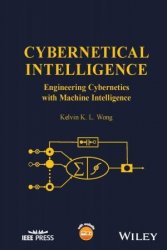Cybernetical Intelligence: Engineering Cybernetics with Machine Intelligence
- Добавил: literator
- Дата: 16-10-2023, 15:57
- Комментариев: 0
 Название: Cybernetical Intelligence: Engineering Cybernetics with Machine Intelligence
Название: Cybernetical Intelligence: Engineering Cybernetics with Machine IntelligenceАвтор: Kelvin K. L. Wong
Издательство: Wiley-IEEE Press
Год: 2024
Страниц: 433
Язык: английский
Формат: pdf (true), epub
Размер: 16.0 MB
Highly comprehensive, detailed, and up-to-date overview of artificial intelligence and cybernetics, with practical examples and supplementary learning resources.
Cybernetical Intelligence: Engineering Cybernetics with Machine Intelligence is a comprehensive guide to the field of cybernetics and neural networks, as well as the mathematical foundations of these technologies. The book provides a detailed explanation of various types of neural networks, including feedforward networks, recurrent neural networks, and convolutional neural networks as well as their applications to different real-world problems. This groundbreaking book presents a pioneering exploration of Machine Learning within the framework of cybernetics. It marks a significant milestone in the field’s history, as it is the first book to describe the development of Machine Learning from a cybernetics perspective. The introduction of the concept of “Cybernetical Intelligence” and the generation of new terminology within this context propel new lines of thought in the historical development of Artificial Intelligence (AI). With its profound implications and contributions, this book holds immense importance and is poised to become a definitive resource for scholars and researchers in this field of study.
Artificial Intelligence (AI) is a field of engineering cybernetics that focuses on the development of intelligent machines that can simulate human-like behaviors such as learning, problem-solving, reasoning, and decision-making. AI technology involves the use of algorithms and computational models to analyze vast amounts of data, recognize patterns and make predictions, and interact with humans through Natural Language Processing (NLP) and other forms of communication.
Deep Learning (DL) is a subset of Machine Learning that uses neural networks with numerous layers in order to learn from complex data. It is a powerful technique that has revolutionized various fields, including computer vision, natural language processing, speech recognition, and robotics. Deep Learning models are trained using large datasets, and they have the ability to learn and generalize from the data to make accurate predictions.
The basic unit of a Deep Learning model is a neural network, which is a collection of nodes or neurons that are organized into layers. Each neuron receives input from other neurons, processes it using an activation function, and produces an output that is sent to other neurons in the next layer. The output of the final layer represents the prediction of the model. Deep Learning models can be trained using supervised, unsupervised, or semi-supervised learning techniques. In supervised learning, the model is trained using labeled data, where the input data is paired with the correct output. In unsupervised learning, the model is trained on unlabeled data, where the objective is to learn the underlying structure of the data. Semi-supervised learning is a combination of both techniques, where the model is trained on a small amount of labeled data and a large amount of unlabeled data. The training of deep learning models is done using optimization techniques such as gradient descent, where the objective is to minimize the loss function.
Each chapter is specifically designed to introduce the theory with several examples. This comprehensive book includes exercise questions at the end of each chapter, providing readers with valuable opportunities to apply and strengthen their understanding of cybernetical intelligence. To further support the learning journey, solutions to these questions are readily accessible on the book’s companion site. Additionally, the companion site offers programming practice exercises and assignments, enabling readers to delve deeper into the practical aspects of the subject matter.
Cybernetical Intelligence includes information on:
The history and development of cybernetics and its influence on the development of neural networks
Developments and innovations in artificial intelligence and machine learning, such as deep reinforcement learning, generative adversarial networks, and transfer learning
Mathematical foundations of artificial intelligence and cybernetics, including linear algebra, calculus, and probability theory
Ethical implications of artificial intelligence and cybernetics as well as responsible and transparent development and deployment of AI systems
Presenting a highly detailed and comprehensive overview of the field, with modern developments thoroughly discussed, Cybernetical Intelligence is an essential textbook that helps students make connections with real-life engineering problems by providing both theory and practice, along with a myriad of helpful learning aids.
Contents:
Скачать Cybernetical Intelligence: Engineering Cybernetics with Machine Intelligence
Внимание
Уважаемый посетитель, Вы зашли на сайт как незарегистрированный пользователь.
Мы рекомендуем Вам зарегистрироваться либо войти на сайт под своим именем.
Уважаемый посетитель, Вы зашли на сайт как незарегистрированный пользователь.
Мы рекомендуем Вам зарегистрироваться либо войти на сайт под своим именем.
Информация
Посетители, находящиеся в группе Гости, не могут оставлять комментарии к данной публикации.
Посетители, находящиеся в группе Гости, не могут оставлять комментарии к данной публикации.

